Your restaurant is a lean, not mean (it’s hospitality after all), dining machine. You have just the right number of servers and bartenders on staff. Any more on a shift would mean overstaffing and additional expenses, and any less on a shift would harm the guest experience. Goldilocks would be proud.
Now business is booming for the first time in years, especially at the bar on Friday and Saturday nights. Your bar is THE place to go for specialty cocktails; your bartenders are full-on mixologists.
It’s Friday and one of your bartenders calls out sick with covid. Suddenly you’re considerably understaffed on bartenders for two reasons: increased customer demand at the bar relative to before, and someone sick means you have a smaller pool of bartenders from which to staff.
Ideally, you could fill this gap by hiring. But it’s a tight market right now, and hiring takes time. You certainly can’t hire someone in less than a day anyways.
So Goldilocks is gone and you’re faced with two undesirable choices. You could turn guests away to avoid a less than perfect guest experience, which means a lost opportunity on drink sales, or admit all guests at the bar, allowing a potentially poor guest experience that could impact your restaurant’s reputation.
BUT IT DIDN’T HAVE TO BE THIS WAY!
What if some of your servers knew some mixology? In other words, what if some servers on staff could also work as bartenders?
This is an example of cross-training, the concept of teaching staff the skills needed to perform multiple jobs. With cross-training, you’re resilient to staff turnover and changes in customer demand because:
- There are more qualified people on staff for each individual job than needed
- But without overstaffing costs because overall the roster is not overstaffed
But how can you implement cross-training? You could train your staff gradually over time. For example, some servers could work a small number of hours bartending each week until they have enough experience to work as a fully fledged bartender.
Cross-Training gets Even Better!
Beyond resilience, there are even more benefits to a cross-trained staff:
More Opportunities for Hours
If staff have the skills to work in multiple jobs (eg, server and bartender), then they have more opportunities for hours. For example, if there is less of a business need for servers and someone can bartend then they are less likely to see their weekly hours dip. Similarly, someone with skills to work in multiple roles could see their hours increase over time because the number of workable hours available to them has increased. More job skills can increase staff hours in times when their hours might otherwise be too low.
Staff Retention
More skills and opportunities for hours make a workplace a better place to work, reducing turnover.
Real-Time Flexibility
Maybe the demand during a shift is more or less than you predicted, and different headcounts for each role are needed. It’s far easier to reassign roles real-time if the team is cross-trained, knowing you can be confident everyone has the experience they need.
The Next Level - Tracking Cross-Training
To truly reap the benefits of cross-training, it’s helpful to track who is qualified for what job(s). This means we can easily see whether any job has too small a pool of staff or whether any specific staff should be cross-trained, and take action to address any gaps we see.
We might track cross-training using a grid like the one below, which is a screenshot from SchedJewel:
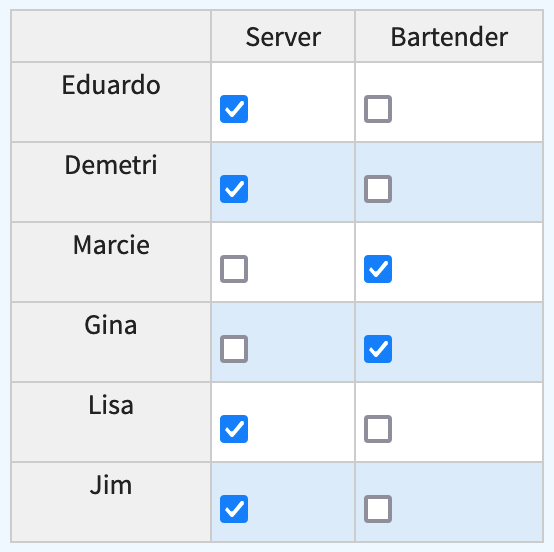
Looking at the cross-training grid above we can see that no one on staff is cross-trained, leaving your operation vulnerable.
The Power of Cross-Training
In the example team shown above, you have 4 servers and 2 bartenders on staff. For simplicity, assume that everyone is available to work every shift, and that all staff are full time and can work between 0 and 40 hours per week; any hours over 40 would mean overtime.
With this in mind, let’s explore the impact on headcount coverage. Suppose our shifts are the following:
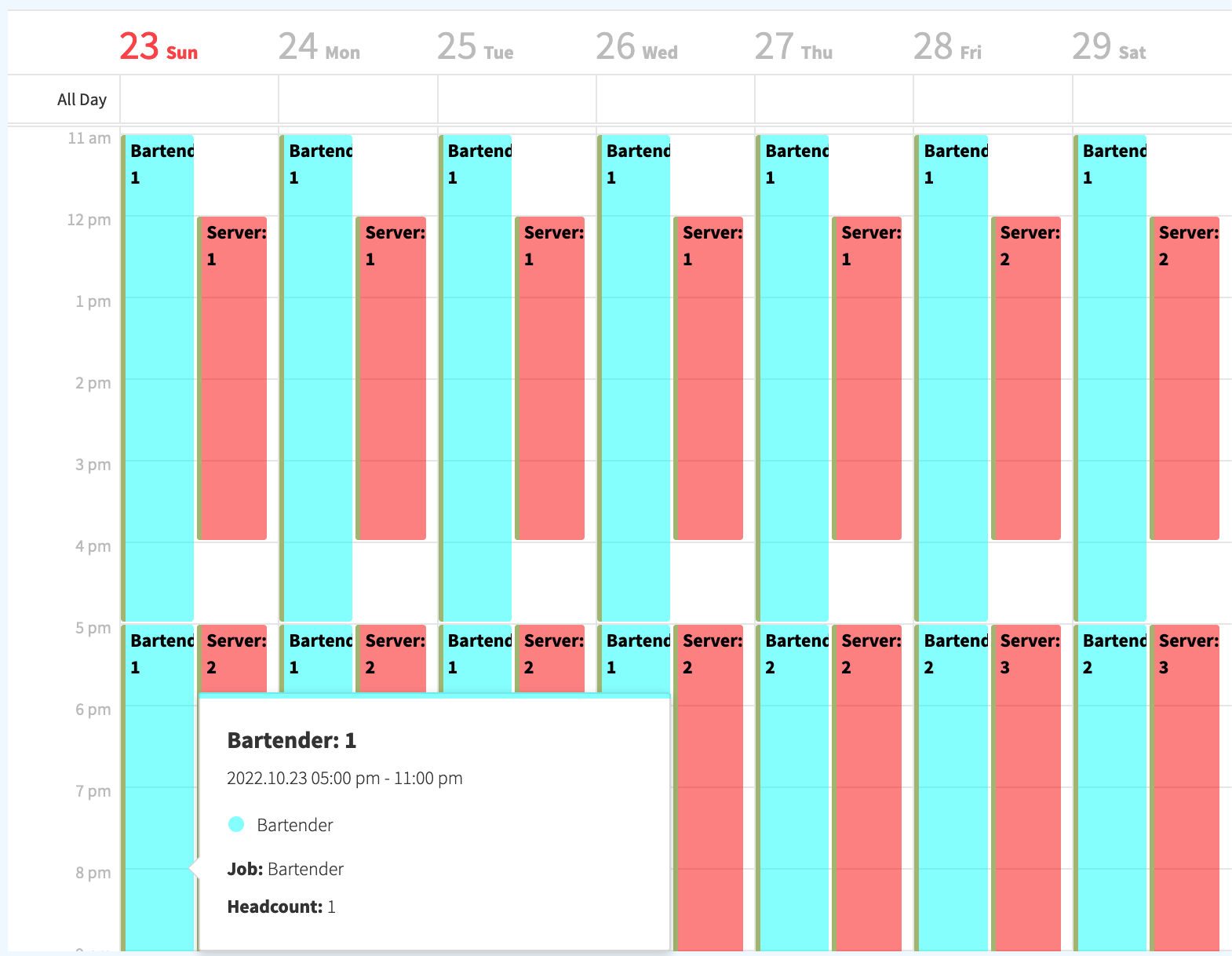
These shifts make up a one week schedule, with lunch and dinner operating hours each day. There are two bartender shifts and two server shifts every day of the week, with varied headcounts to account for variation in customer demand:
- Server Shifts: 12pm-4pm , 5pm-10pm every day
- Bartender Shifts: 11am-5pm , 5pm-11pm every day
Fully Staffing all shifts may be more difficult Without Cross-Training
Any schedule adhering to the shifts, job skills, maximum hours, and complete availability described above will be understaffed for bartenders. In fact, the best possible schedule is understaffed for bartenders on 5 shifts.
This is as good as it gets, which isn’t very good. How do I know that? Feel free to ask me (but here’s a hint).
We can see the understaffed shifts and potential candidates we could staff to fill the gaps in headcount.
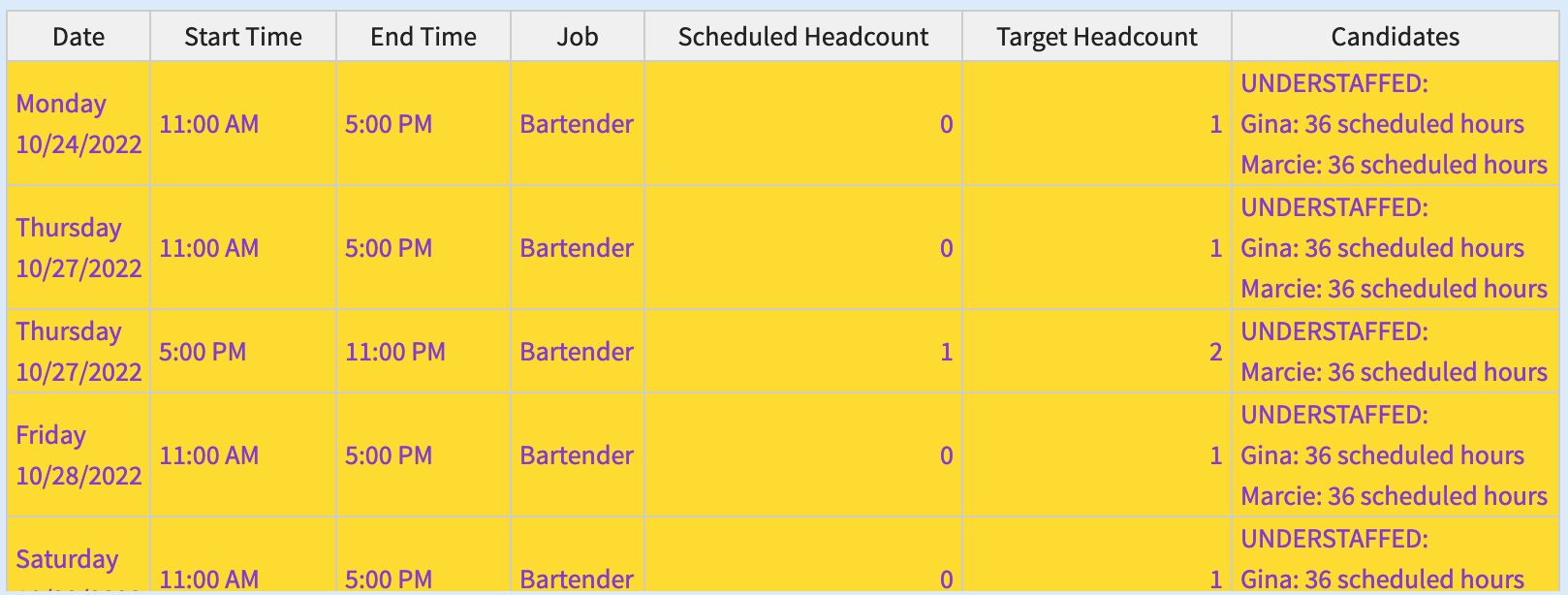
You might be wondering why the recommended candidates weren’t assigned for these shifts in the first place if we’re understaffed. Let’s look at the currently scheduled hours for each candidate. In the schedule created, both bartenders (Gina and Marcie) are assigned 36 hours. If either person works one more shift then their hours will go over 40. That means overtime. Consequently, assigning any more shifts to Gina or Marcie is NOT an ideal schedule.
Cross-Training Means Fully Staffed Shifts!
Now suppose you cross-trained two servers: Lisa and Jim. They now have the skills to work both as a server and a bartender. You have the same staff as before, with no new hires.

By cross-training just two people something amazing happens… Your shifts are all fully staffed! Goldilocks is back!
Where we once had a table of understaffed shifts, we now have a reassuring message:

We can also review our shifts relative to their target headcounts in a calendar format:
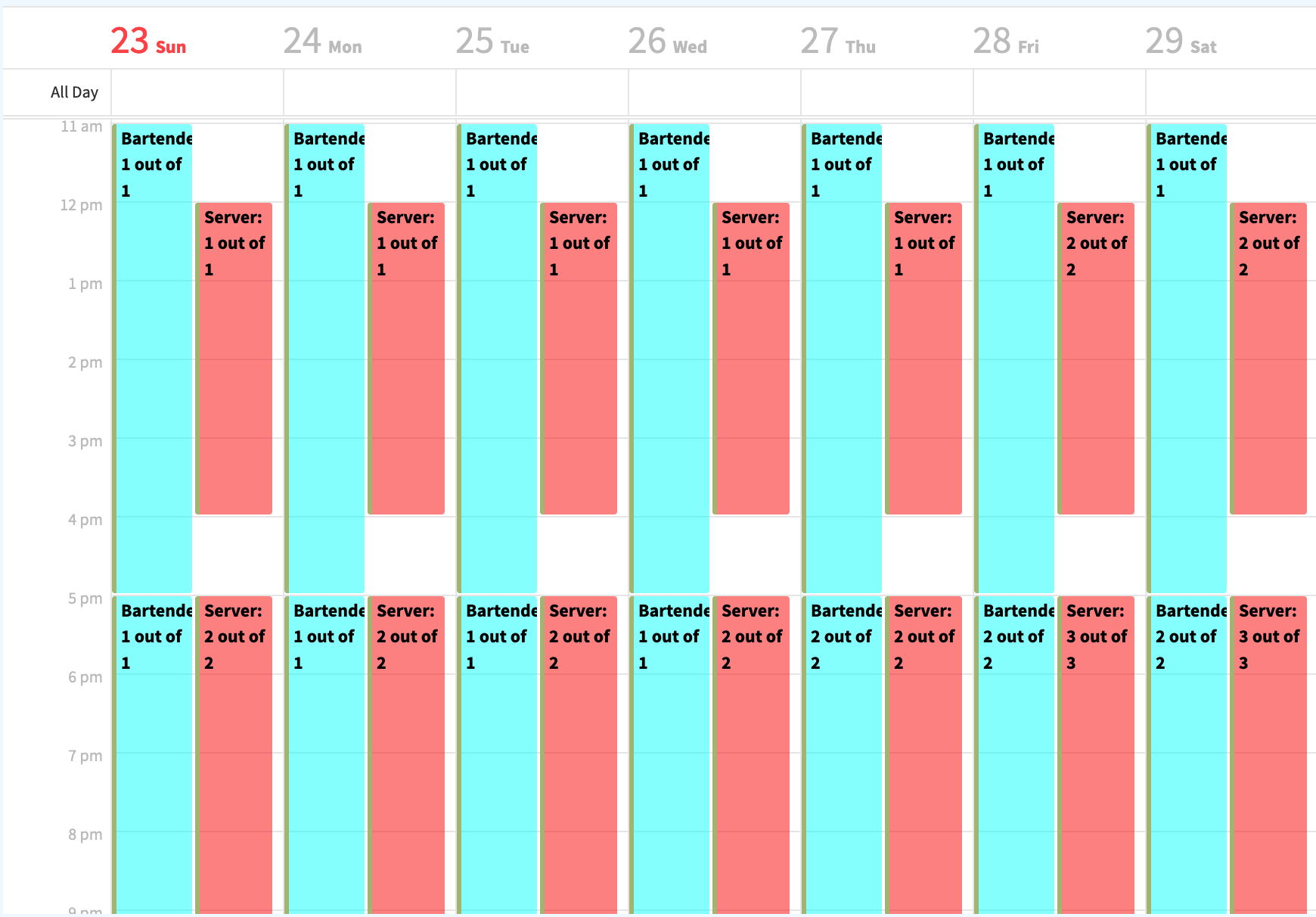
That sounds wonderful, but what about the total hours each person is scheduled to work? Does this schedule adhere to our “maximum of 40 hours” requirement? Indeed it does! Here are two screenshots of the scheduled hours for each employee as compared to that employee’s minimum and maximum hours (0 and 40, respectively, in this example case):
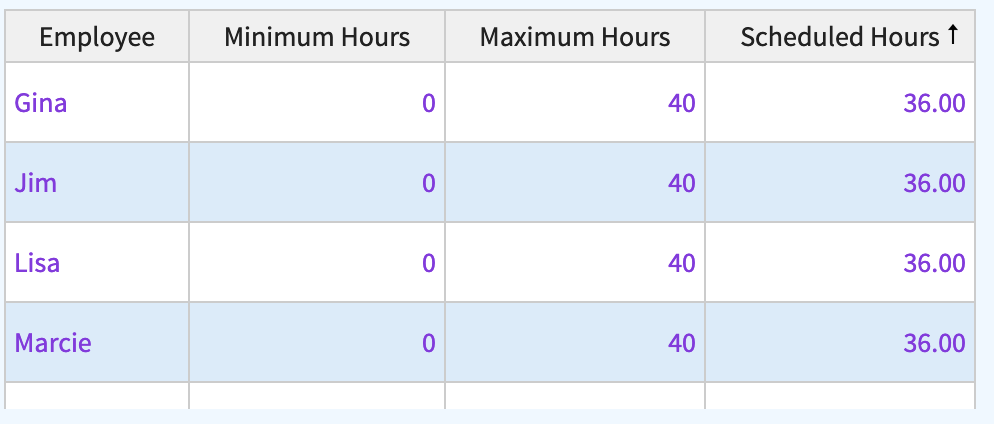
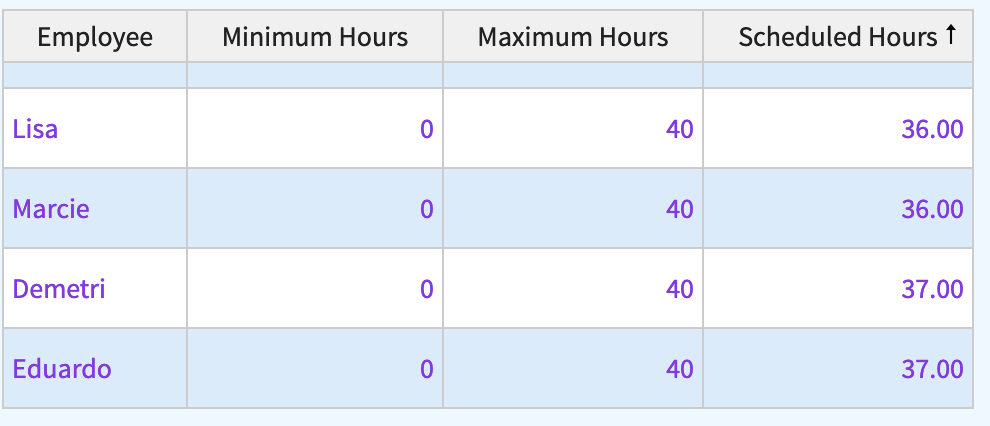
As you can see, all staff are working under 40 hours, which respects the hours requirements. But it gets better - the total hours assigned to each person are nearly equal across staff! Everyone is working either 36 or 37 hours. This is no accident. From an equitable hours perspective this is as good as it gets. SchedJewel allocates hours as equitably as possible, while addressing all schedule requirements.
Cross-Training - a Powerful Play
We’ve seen how training staff in multiple job functions is good for both the employer and the employees. Cross-training means:
- Resilience
- Flexibility
- More opportunities for hours
- Improved staff retention
- Reduced understaffing, potentially even fully-staffed shifts where there was understaffing before
Of course, these benefits aren’t specific to restaurants. They apply to nearly any hourly workplace with multiple jobs, such as hotels, warehouses, and retail stores.
Instead of training new people to fill the gaps in your shifts, train the people you already have on staff.